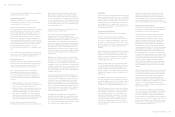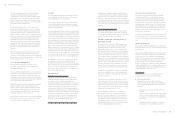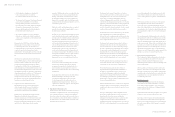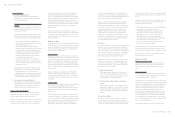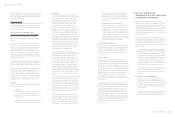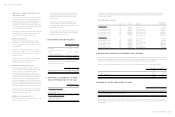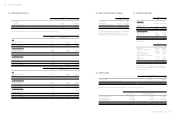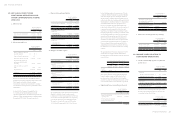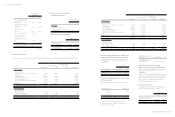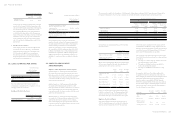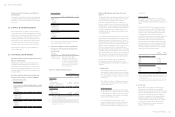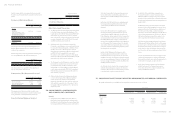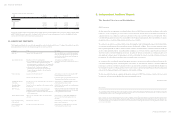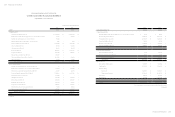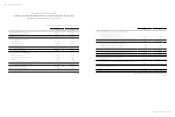HTC 2015 Annual Report Download - page 110
Download and view the complete annual report
Please find page 110 of the 2015 HTC annual report below. You can navigate through the pages in the report by either clicking on the pages listed below, or by using the keyword search tool below to find specific information within the annual report.
Financial information
Financial information
216
217
actuarial assumptions will occur and all other assumptions
will remain constant, the present value of the defined benefit
obligation would (increase) decrease as follows:
December 31
2015 2014
Discount rate
0.25% increase $ 17,330 $ 15,482
0.25% decrease $ (18,169) $ (16,220)
Expected rate of salary increase
0.25% increase $ (17,518) $( 15,671)
0.25% decrease $ 16,810 $ 15,046
The sensitivity analysis presented above may not be
representative of the actual change in the present value of
the defined benefit obligation as it is unlikely that the change
in assumptions would occur in isolation of one another as
some of the assumptions may be correlated.
December 31
2015 2014
The expected contributions to the
plan for the next year $ 35,034 $ 23,588
The average duration of the defined
benefit obligation 15.68 years 14.86 years
21. EQUITY
Share Capital
a. Ordinary shares
December 31
2015 2014
Numbers of shares authorized (in
thousands of shares)
1,000,000
1,000,000
Shares authorized $10,000,000 $10,000,000
Number of shares issued and fully
paid (in thousands of shares) 831,870 834,952
Shares issued $ 8,318,695 $ 8,349,521
In February and October 2014, the Company retired
1,999 thousand and 10,000 thousand treasury shares
amounting to NT$19,984 thousand and NT$100,000
thousand, respectively. In November 2014, the Company
issued 4,600 thousand restricted shares for employees
amounting to NT$46,000 thousand. As a result, the
amount of the Company's outstanding ordinary shares
as of December 31, 2014 decreased to NT$8,349,521
thousand, divided into 834,952 thousand ordinary
shares at NT$10 par value. Every ordinary share carries
one vote per share and a right to dividends.
In March 2015, the Company retired 6,914 thousand
treasury shares amounting to NT$69,140 thousand.
In August and December 2015, the Company issued
400 thousand and 4,006 thousand restricted shares
for employees amounting to NT$4,000 thousand
and NT$40,060 thousand respectively. In April, July
and October 2015, the Company retired 49 thousand,
117 thousand and 409 thousand restricted shares for
employees amounting to NT$492 thousand, NT$1,167
thousand and NT$4,087 thousand, respectively. As
a result, the amount of the Company's outstanding
ordinary share as of December 31, 2015 decreased to
NT$8,318,695 thousand, divided into 831,870 thousand
ordinary shares at NT$10 par value. Every ordinary
share carries one vote per share and a right to dividends.
80,000 thousand shares of the Company's shares
authorized were reserved for the issuance of employee
share options.
b. Global depositary receipts
In November 2003, the Company issued 14,400
thousand ordinary shares corresponding to 3,600
thousand units of Global Depositary Receipts (“GDRs”).
For this GDR issuance, the Company's stockholders,
including Via Technologies, Inc., also issued 12,878.4
thousand ordinary shares, corresponding to 3,219.6
thousand GDR units. Thus, the entire offering consisted
of 6,819.6 thousand GDR units. Taking into account the
effect of stock dividends, the GDRs increased to 8,782.1
thousand units (36,060.5 thousand shares). The holders
of these GDRs requested the Company to redeem the
GDRs to get the Company's ordinary shares. As of
December 31, 2015, there were 8,397.4 thousand units
of GDRs redeemed, representing 33,589.4 thousand
ordinary shares, and the outstanding GDRs represented
2,471.1 thousand ordinary shares or 0.30% of the
Company's outstanding ordinary shares.
Capital Surplus
December 31
2015 2014
May be used to offset a deficit,
distributed as cash dividends, or
transferred to share capital
Arising from issuance of ordinary
shares $14,312,926 $14,432,437
Arising from consolidation excess 23,604 23,801
Arising from expired stock options 35,825 36,124
May not be used for any purpose
Arising from employee share
options 544,087 250,470
Arising from employee restricted
shares 589,411 397,855
$15,505,853 $15,140,687
The capital surplus arising from shares issued in excess of
par (including share premium from issuance of ordinary
shares, treasury share transactions, consolidation excess and
expired stock options) and donations may be used to offset
a deficit; in addition, when the Company has no deficit,
such capital surplus may be distributed as cash dividends or
transferred to share capital (limited to a certain percentage
of the Company's capital surplus and once a year).
In February and October 2014, the retirement of treasury
shares caused decreases of NT$208,546 thousand in
additional paid-in capital - issuance of ordinary shares,
NT$1,499 thousand in capital surplus - treasury shares,
NT$344 thousand in capital surplus - consolidation excess
and NT$522 thousand in capital surplus - expired stock
options. The difference the carrying value of treasury shares
retired in excess of the sum of its par value and premium
from issuance of common share was firstly offset against
capital surplus - treasury shares by NT$630,292 thousand,
and the rest offset against unappropriated earnings
amounting to NT$8,208,915 thousand.
In March 2015, the retirement of treasury shares caused
decreases of NT$119,511 thousand in additional paid-in
capital - issuance of ordinary shares, NT$197 thousand in
capital surplus - consolidation excess, NT$299 thousand in
capital surplus - expired stock options, respectively. The
difference the carrying value of treasury shares retired in
excess of the sum of its par value and premium from issuance
of ordinary share was offset against unappropriated earnings
amounting to NT$3,560,909 thousand.
For details of capital surplus - employee share options and
employee restricted shares, please refer to Note 26.
Retained Earnings and Dividend Policy
Under the Company's Articles of Incorporation, the
Company should make appropriations from its net income
in the following order:
a. To pay taxes.
b. To cover accumulated losses, if any.
c. To appropriate 10% legal reserve unless the total legal
reserve accumulated has already reached the amount of
the Company's authorized capital.
d. To recognize or reverse special reserve return earnings.
e. To pay remuneration to directors and supervisors
at 0.3% maximum of the balance after deducting the
amounts under the above items (a) to (d).
f. To pay bonus to employees at 5% minimum of the
balance after deducting the amounts under the above
items (a) to (d), or such balance plus the unappropriated
retained earnings of previous years. However, the
bonus may not exceed the limits on employee bonus
distributions as set out in the Regulations Governing the
Offering and Issuance of Securities by Issuers. Where
bonus to employees is allocated by means of new share
issuance, the employees to receive bonus may include
the affiliates' employees who meet specific requirements
prescribed by the board of directors.
g. For any remainder, the board of directors should
propose allocation ratios based on the dividend policy
set forth in the Company's Articles and propose them at
the stockholders' meeting.
As part of a high-technology industry and as a growing
enterprise, the Company considers its operating
environment, industry developments, and long-term
interests of stockholders as well as its programs to maintain
operating efficiency and meet its capital expenditure
budget and financial goals in determining the stock or
cash dividends to be paid. The Company's dividend policy
stipulates that at least 50% of total dividends may be
distributed as cash dividends.
In accordance with the amendments to the Company Act
in May 2015, the recipients of dividends and bonuses are
limited to shareholders and do not include employees. The
Company expects to modify the Articles of Incorporation
according to laws and regulations above on the board
of directors' meeting on February 29, 2016 and will be
subjected to the resolution of the shareholders' meeting.
For information about the accrual basis of the employees'
compensation and remuneration to directors and


